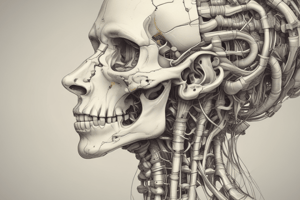Podcast
Questions and Answers
What is the primary reason the atlas is named as such?
What is the primary reason the atlas is named as such?
- It supports extensive muscle attachment.
- It is the largest vertebra in the cervical spine.
- It provides stability to the spine.
- The head rests upon it. (correct)
Which characteristic is unique to the atlas (C1) compared to other cervical vertebrae?
Which characteristic is unique to the atlas (C1) compared to other cervical vertebrae?
- It has a very large spinous process.
- It possesses transverse processes.
- It has no spinous process. (correct)
- It allows for lateral flexion.
What joint allows for the majority of flexion and extension in the cervical spine?
What joint allows for the majority of flexion and extension in the cervical spine?
- Thoracic vertebrae joint.
- Atlanto-occipital joint. (correct)
- Atlanto-axial joint.
- Cervical intervertebral disc.
What is the primary function of the dens in the atlantoaxial joint?
What is the primary function of the dens in the atlantoaxial joint?
Which statement correctly describes the shape of the superior articular facet of the atlas?
Which statement correctly describes the shape of the superior articular facet of the atlas?
How much cervical rotation occurs at the atlantoaxial joint?
How much cervical rotation occurs at the atlantoaxial joint?
What is the anatomical position of the atlas in relation to the axis?
What is the anatomical position of the atlas in relation to the axis?
What unique feature of the cervical spine allows the passage of the vertebral artery?
What unique feature of the cervical spine allows the passage of the vertebral artery?
How are the superior and inferior articular facets of the cervical spine oriented?
How are the superior and inferior articular facets of the cervical spine oriented?
What is the primary function of the uncinate processes in the cervical spine?
What is the primary function of the uncinate processes in the cervical spine?
Which segment of the cervical spine is primarily associated with the atlas?
Which segment of the cervical spine is primarily associated with the atlas?
Which characteristic of the cervical spine facets is critical for motion?
Which characteristic of the cervical spine facets is critical for motion?
What is the role of the intervertebral discs found in the cervical spine?
What is the role of the intervertebral discs found in the cervical spine?
Which two features are similar across the cervical, thoracic, and lumbar spines?
Which two features are similar across the cervical, thoracic, and lumbar spines?
What stabilizing feature is present from segments C3 through C6 in the cervical spine?
What stabilizing feature is present from segments C3 through C6 in the cervical spine?
Flashcards are hidden until you start studying
Study Notes
Cervical Spine Osteology
- The cervical spine consists of seven vertebrae (C1-C7) with unique features compared to other spinal segments.
- Common features shared with thoracic and lumbar vertebrae include spinous processes, laminae, and pedicles.
Unique Cervical Vertebrae Features
- Transverse Foramen: An opening in each transverse process allowing passage of the vertebral artery supplying blood to the brain.
- Articular Facets: Large facets with specific orientations dictating the range of motion. Superior facets face superiorly and posteriorly; inferior facets face inferiorly and anteriorly.
- Uncinate Processes (C3-C6/C7): Vertical projections providing frontal plane stability and supporting intervertebral discs.
C1 (Atlas)
- Lacks a spinous process; possesses a posterior tubercle instead.
- Large transverse processes for fine head movement control.
- Superior articular facets are concave to articulate with the convex occipital condyles.
C1-Occipital Joint (Atlanto-Occipital Joint - AO Joint)
- The AO joint is formed by the articulation of the occipital condyles (cranium) and the superior articular facets of C1 (atlas).
- Accounts for approximately 50% of cervical flexion and extension.
C2 (Axis)
- Distinctive dens (odontoid process) projecting vertically.
- The dens acts as a fulcrum for rotation, contributing to approximately 50% of cervical rotation.
- The atlas (C1) rests and rotates around the dens of the axis (C2), forming the atlantoaxial joint (AA joint).
Studying That Suits You
Use AI to generate personalized quizzes and flashcards to suit your learning preferences.



